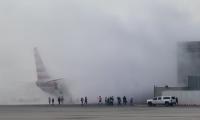cost was $5.27 million per km); China’s Beijing system (commissioned in 2004; cost: $4.8 million per kilometre; with average inflation at 1.38 percent the adjusted cost was $8.03 million per km); Paris’ First Line system (commissioned in 2005; cost: $7 million per kilometre; with average inflation at 4.01 percent the adjusted cost was $5.27 million per km); Istanbul’s system (commissioned in 2007; cost: $8.8 million per kilometre; with average inflation at 7.43 percent the adjusted cost was $15.61 million per km). The Lahore MBS was commissioned in 2013 and cost $11 million per kilometre; with average inflation at 8 percent the adjusted cost was $12.83 million per km. And now the PMBS: commissioned in 2015, it cost: $20 million per kilometre; with average inflation at 8 percent the adjusted cost was $20 million per km. [Please see Table 1 in the inside pages of the paper]
The per kilometre cost also varies depending upon the extent of roadway improvements supplementary to the main corridor. Some of the major roadway improvements in the PMBS include a cloverleaf interchange at Peshawar Morr (Rs4,940 million), new bridge on Nala Lai (Rs352 million), rehabilitation of the existing road network and other additional works (Rs2,705 million). After adjustment of these components not directly related with the project, the cost is reduced to $16.360 million per kilometre.
Generally, the international per kilometre cost does not include costs of land acquisition, escalators, elevators, platform sliding doors, generators, etc in the civil works costs. For example, land acquisition in our country is necessitated because of right of way constraints which factor is absent in more developed cities where the existing planned right of way is used. Escalators/elevators are required to facilitate passenger access to elevated section, trenched section and platforms located in the centre of the existing right of way.
In the case of the PMBS, costs for these items are included in the total project cost of Rs44,840 million. The information available on the quoted BRT examples was reviewed on websites (www.worldbrt.net and www.brtdata.org) and the following information pertaining to additional facilities was revealed:
The Ahmedabad system has no escalators, elevators and generators or passing lanes. It does have PSDs. In Changzhou China there are elevators and escalators but no generators and passing lanes. Beijing China has no such facilities. Paris’ First Line system also has no such facilities, while in the Istanbul system too there are no escalators, elevators are less than 20 percent and no PSDs or passing lanes exist. The Lahore MBS, on the other hand, has escalators, PSDs, generators and passing lanes. The PMBS is to have all the above-mentioned facilities. [Table 2 given in the inside pages]
After adjustment of the cost of additional facilities like elevators, escalators, PSDs, passing lanes and generators (PKR 2,935M) the PMBS cost is further reduced to $15.09 million per kilometre.
One-on-one comparison of cost is not justifiable due to differences in geometric design (elevated, at-grade and trench sections) and various other BRT features provisioned for facilitation of passengers. For example, in the PMBS, 8.6km is elevated and 4km is trench section which have a significant impact on cost. As seen below, the PMBS is designed to include all types of sections whereas other BRTs are predominantly designed as at-grade facilities.
Looking at elevation, at-grade, trench and total of the length of section, we see that the Ahmedabad system has no elevation or trench, its at-grade is 39 and total 39 as well. Changzhou too has no elevation or trench and its total is 54. Beijing shows a similar situation (some trench sections present but insignificant) and its total is 79. Paris’ First Line too has some trench section but insignificant, no elevation and its total is 19. Istanbul has no elevation, no trench and a total of 51.7. The Lahore MBS has elevation of 8.3, at-grade of 18.7, no trench section and a total of 27. The PMBS has elevation of 8.6, at-grade of 9.8, trench 4 and total of 22.4. [Table 3 provided in the inside pages]
All of the quoted examples are at-grade facilities. If the PMBS was also planned as an at-grade facility its per kilometre cost would work out to $10.780M per kilometre.
The PMBS was designed for a peak capacity of 24, 480 passengers per hour per direction (pphpd). As may be seen below the capacities of quoted BRT examples are far less, except the Istanbul Metrobus (Source: BRT Planning Guide, 2007):
In Ahmedabad the system capacity of passenger per hour per direction (pphpd) is 3, 570, the number of docking days for articulates bus is one day and the demand pphpd is 1,200. Changzhou has a system capacity of 8, 160, number of docking days one and demand of 3, 450. The Beijing system’s system capacity is 8,160, number of docking days one and demand pphpd is 2,850. Istanbul has system capacity of 24,480, three days for docking and demand of 18,900. The PMBSs system capacity pphpd is 24,480, three docking days and demand of 4000 pphpd. [Please see Table 4 in the inside pages]
Except for Istanbul all of the other quoted examples are designed at smaller passenger ridership necessitating single docking bay at the stations.
Currently, the PMBS passenger demand is 4000 pphpd. The PMBS would have exhausted its capacity in the initial days of its operation if planned at the Ahmadabad BRT’s capacity. If the PMBS was designed at a reduced system capacity like the other quoted BRTs, the cost per kilometre would have been reduced to $5.460M per kilometre.
The writer’s assertion that the metro bus projects in Punjab are high cost undertakings is also not correct as the Boston BRT, built at a price of $53.000 million per kilometre holds the record of being the most costly BRT in the world, followed by Nagoya with $47.000 million per kilometre), Pittsburgh West Busway – $31.500 million per kilometre, and Brisbane – $24.000 million per kilometre. [Source: Hensher, D 2008, Frequency and Connectivity: the Key Drivers of Reform in Urban Public Transport Provision, Institute of Transport and Logistics Studies, University of Sydney].
Expeditious execution of projects has multiple benefits and as such it is inappropriate to say that the government was in a rush. One, it obviates the need for project revisions resulting in cost overruns. Two, it facilitates unleashing project benefits to the public sooner than later. Three, it minimises public inconvenience during the construction phase.
We have utmost respect for all of our honourable columnists and fully recognise their right to formulate and hold opinions on national issues. We, however, do expect that while stating facts careful due diligence and adequate research is carried out to ensure that the facts at least are not distorted.
For the relevant tables please see the inside pages.
The writer is managing director, Punjab Masstransit Authority. Email: info.pma@punjab.gov.pk
People of that time believed that an eclipse was a symbol of displeasure of gods
Debt-to-GDP ratio, which stood at 51% in 2009-10, peaked at 74% in 2019-20 and remains alarmingly high at 65% in 2023-24
Point is not to pour cold water over government’s achievements, but to look at baseline metrics
Loss of biodiversity is stark reminder that urban mismanagement is not just infrastructural failure but ecological...
Strong public warning systems can also help ensure quick evacuations in places prone to fires
PPPs in Pakistan's WASH sector face significant regulatory and policy challenges that hinder their effectiveness







